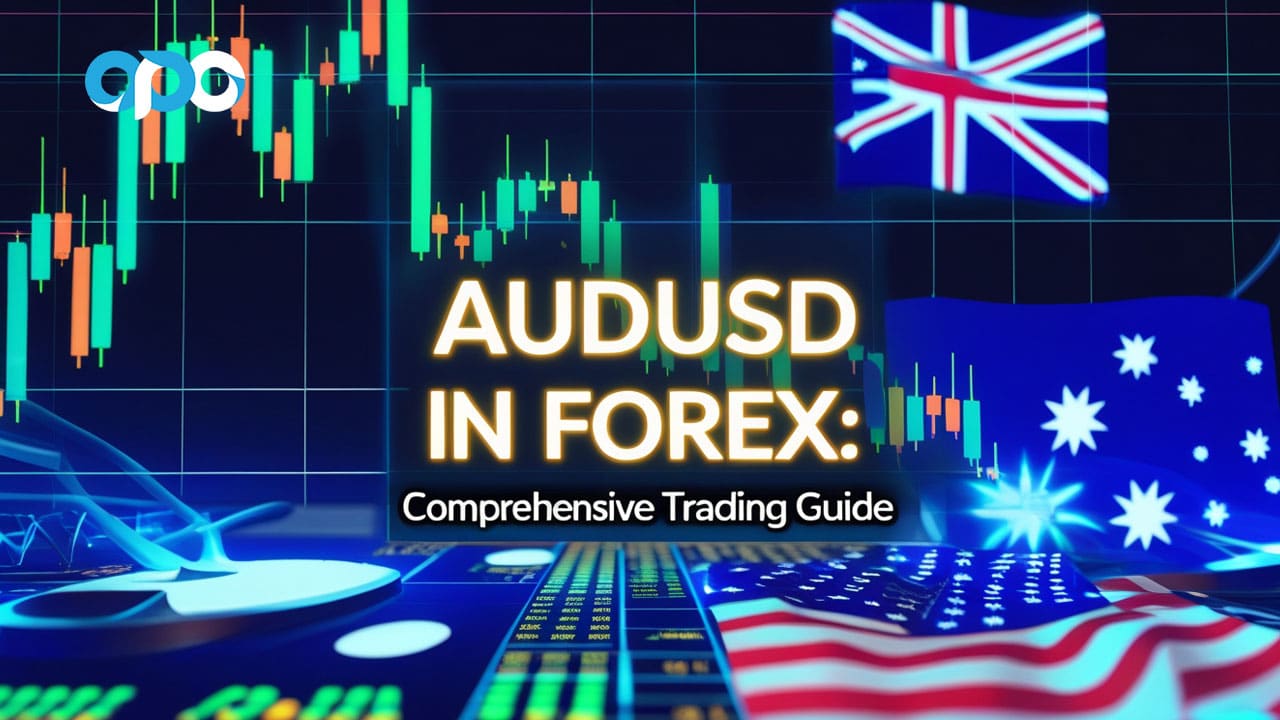Are you striving to boost your forex trading success and seeking the next big opportunity? Discover how the AUDUSD currency pair can transform your trading strategy with its dynamic movements and robust potential. In this comprehensive guide, we’ll delve deep into what AUDUSD in forex is, unravel the factors that influence its fluctuations, and equip you with actionable strategies to maximize your trading profits.

The AUD/USD currency pair, affectionately known as the “Aussie,” is a cornerstone in the forex market that offers both robust opportunities and unique challenges. Understanding what is AUDUSD in forex and how it operates can significantly impact your trading success. This in-depth guide explores the intricacies of the AUD/USD pair, including its historical context, key influencing factors, effective trading strategies, and recent market trends. Whether you’re a novice or a seasoned trader, this article provides valuable insights to help you navigate the complexities of AUDUSD forex trading with confidence and precision.
Understanding What is AUDUSD in Forex

The AUD/USD currency pair is one of the most actively traded pairs in the foreign exchange (forex) market. This pair represents the exchange rate between the Australian Dollar (AUD) and the United States Dollar (USD). In this context, the AUD is the base currency, and the USD is the quote currency. Essentially, the AUD/USD pair indicates how much one Australian Dollar is worth in US Dollars. For example, an AUD/USD rate of 0.7500 means that 1 AUD is equivalent to 0.75 USD.
Grasping the fundamentals of the AUD/USD pair is crucial for traders aiming to maximize their forex trading potential.
Base and Quote Currencies Explained
In any currency pair, the first currency listed is the base currency, while the second is the quote currency. For the AUD/USD pair:
- Base Currency (AUD): This is the currency being bought or sold. When you purchase AUD/USD, you are buying AUD and selling USD.
- Quote Currency (USD): This is the currency used to make the transaction. Selling AUD/USD means you are selling AUD and buying USD.
Understanding the dynamics between the base and quote currencies helps traders make informed decisions about buying or selling the pair based on market movements and economic indicators.
Read More: what is audcad in forex
Historical Context of AUD/USD
The Birth of the Australian Dollar
The Australian Dollar (AUD) was introduced in 1966, replacing the Australian Pound at a rate of 2 AUD to 1 GBP. This transition marked Australia’s move towards a more flexible and internationally recognized currency. Initially pegged to the British Pound and later to the US Dollar, the AUD became a free-floating currency in 1983. This shift allowed the AUD’s value to be determined by market forces without direct government intervention, paving the way for increased volatility and trading opportunities in the forex market.
The introduction and evolution of the AUD have significantly influenced its standing in the global forex arena.
Evolution of the AUD/USD Exchange Rate
Since its inception, the AUD/USD exchange rate has undergone substantial fluctuations influenced by various economic and geopolitical factors. Historically, the AUD has been classified as a commodity currency due to Australia’s abundant natural resources, including iron ore, coal, and natural gas. This classification means that the AUD is particularly sensitive to changes in commodity prices. For instance, during periods of rising iron ore prices, the AUD tends to strengthen against the USD, while declining commodity prices can exert downward pressure on the AUD.
Over the decades, significant events such as Australia’s economic reforms, global financial crises, and shifts in trade relationships have continually shaped the AUD/USD dynamics. Understanding this historical context is essential for traders looking to predict future movements and make strategic trading decisions.
Factors Influencing AUD/USD

The AUD/USD exchange rate responds to various elements that shape its short-term fluctuations and long-term trends. Understanding these key drivers is vital for making well-informed trading decisions.
Commodity Prices Impact
Australia’s economy heavily depends on the export of natural resources such as iron ore, coal, and natural gas. Higher commodity prices typically boost Australian export revenues, strengthening the AUD against the USD. For instance, a surge in iron ore prices—often spurred by demand from China—can increase the country’s trade surplus, lifting the AUD. Conversely, declining commodity prices reduce export earnings and can weigh down the AUD.
Keeping track of global commodity price indices and monitoring reports from major commodity exchanges can help traders anticipate future movements in the AUD/USD pair.
Trade Relationships with China and the United States
Australia’s trade ties with China and the U.S. significantly influence the AUD/USD exchange rate. When China’s economy flourishes, demand for Australian commodities rises, often causing the AUD to appreciate. On the other hand, if China imposes tariffs or reduces imports from Australia, the AUD can weaken.
The United States, as the largest global economy, affects the USD’s strength. A robust U.S. economy typically boosts the USD, nudging the AUD/USD pair lower. Economic slowdowns or policy shifts in either China or the U.S. can alter trade flows and quickly alter the AUD’s value.
Monitoring geopolitical events, economic indicators, and policy changes in both China and the U.S. is crucial for forecasting potential AUD/USD shifts.
Interest Rate Differentials
Differences in interest rates set by the Reserve Bank of Australia (RBA) and the U.S. Federal Reserve are pivotal for AUD/USD valuation. Higher Australian rates can attract foreign capital seeking more attractive yields, pushing the AUD upward against the USD. Conversely, if U.S. rates rise or Australian rates drop, the AUD may depreciate.
Central banks’ interest rate decisions are often tied to inflation trends and economic performance. Traders watch RBA and Federal Reserve announcements closely, as any hint of future rate policy can prompt market swings in the AUD/USD pair.
Economic Indicators and Data Releases
Australia and the U.S. regularly publish economic reports—such as GDP growth, employment data, and inflation figures—that shape market sentiment around the AUD/USD pair. Strong Australian data can bolster the AUD, while disappointing reports often spark sell-offs. Similarly, robust U.S. figures can strengthen the USD, pressuring the AUD/USD pair downward.
Key indicators include: GDP Growth (signals economic vitality),
Employment Data (measures labor market health),
Inflation Rates (influences monetary policy),
Trade Balance (gauges export-import differentials).
Staying updated on economic calendars and relevant data releases for both countries enables traders to react quickly to market-moving developments.
Geopolitical Events and Global Sentiment
Political stability, diplomatic relations, and international conflicts can all affect AUD/USD price action. For example, major trade disputes, unexpected election results, or tensions between global powers may spark volatility, leading traders to seek safe-haven currencies like the USD. Conversely, signs of stable governance or favorable trade agreements can uplift the AUD.
Global sentiment—shaped by events like pandemics, international crises, or natural disasters—further impacts investor confidence. Traders tracking headlines and geopolitical developments can position themselves for potential market swings in the AUD/USD pair.
Market Speculation and Investor Behavior
Speculative activity and market psychology play a significant role in short-term AUD/USD fluctuations. When large traders anticipate a bullish AUD, they may accumulate long positions, driving the exchange rate higher. Negative sentiment or bearish forecasts can trigger selling pressure, sending the AUD/USD lower.
This interplay between fundamental factors and market psychology means traders must strike a balance between data-driven analysis and awareness of shifting investor sentiment. Leveraged trading also amplifies price changes, as rapid liquidations can fuel sharp price moves.
Read More: Major Currency Pairs in Forex
Trading the AUD/USD Pair

Trading the AUD/USD pair offers numerous opportunities due to its liquidity and volatility. Understanding the trading hours, peak volatility periods, and effective strategies can significantly enhance your trading performance.
Trading Hours and Peak Volatility
The AUD/USD pair is actively traded during the Asian and North American sessions, with peak volatility typically occurring when these markets overlap. The Australian market is open from 10 PM to 7 AM GMT, while the U.S. market operates from 1 PM to 10 PM GMT. Traders often experience heightened volatility and increased trading opportunities during these overlapping hours.
For instance, the period between 1 PM and 4 PM GMT, when both the Australian and U.S. markets are active, is known for significant price movements in the AUD/USD pair. Understanding these peak times can help traders plan their trades to coincide with periods of higher liquidity and volatility, potentially maximizing profit potential.
Timing your trades to coincide with peak volatility periods can maximize profit potential and trading efficiency.
Effective Trading Strategies
Successful AUDUSD forex trading requires a blend of technical and fundamental analysis. Here are some strategies to consider:
Trend Following: Identifying and following the prevailing trend can help capture significant price movements. For example, if the AUD/USD pair is in an uptrend, traders may look to enter long positions, riding the momentum until signs of reversal emerge.
Breakout Trading: Trading on price breakouts from established support and resistance levels can be lucrative during volatile periods. For instance, if the AUD/USD pair breaks above a key resistance level, it may signal the start of a new upward trend, presenting a buying opportunity.
Carry Trade: Leveraging interest rate differentials between Australia and the U.S. can generate returns through carry trades. By borrowing in a currency with a lower interest rate (e.g., USD) and investing in a currency with a higher interest rate (e.g., AUD), traders can earn the difference in interest rates as profit.
Implementing robust trading strategies tailored to the AUD/USD pair’s unique characteristics can enhance trading outcomes.
Utilizing Economic Indicators
Economic indicators such as GDP growth, unemployment rates, and inflation figures from Australia and the United States provide valuable insights into the AUD/USD exchange rate. Key indicators to monitor include:
- Australian GDP Growth: Strong GDP growth signals a healthy economy, potentially strengthening the AUD.
- U.S. Non-Farm Payrolls: Robust employment data can strengthen the USD, affecting the AUD/USD pair.
- Inflation Rates: Higher inflation in Australia may lead to higher interest rates, boosting the AUD.
- Trade Balance Reports: A positive trade balance in Australia can support a stronger AUD.
Staying informed about key economic indicators empowers traders to anticipate and react to market movements effectively.
Read More: audusd scalping strategy
Recent Trends and Analysis
Understanding recent trends in the AUD/USD exchange rate is vital for developing effective trading strategies. Let’s examine the current landscape and the factors influencing recent movements.
Recent Movements in AUD/USD Exchange Rate
In the past year, the AUD/USD pair has exhibited significant volatility, influenced by fluctuating commodity prices, shifting trade dynamics, and changing interest rate policies. For instance, a surge in iron ore prices has bolstered the AUD, while concerns over global economic slowdowns have impacted the USD’s strength. Additionally, geopolitical tensions and shifts in trade agreements have contributed to the pair’s volatility.
Staying updated on recent movements and underlying factors is crucial for adapting your trading strategy to current market conditions.
Analysis of Current Economic Factors
Several economic factors are currently shaping the AUD/USD pair:
- Commodity Market Fluctuations: Changes in iron ore and coal prices continue to impact the AUD. For example, rising iron ore prices due to increased demand from China have strengthened the AUD.
- Economic Performance: Australia’s GDP growth and employment data influence investor confidence in the AUD. Recent data showing robust economic growth has supported the AUD.
- Monetary Policy: Recent interest rate decisions by the RBA and the Federal Reserve are pivotal in determining the pair’s direction. For example, if the RBA signals a rate hike while the Federal Reserve holds rates steady, the AUD/USD pair may strengthen.
Analyzing these economic factors provides a comprehensive understanding of the forces driving the AUD/USD exchange rate.
Opofinance Services
When navigating the complexities of AUD/USD forex trading, partnering with a reliable broker is essential. Opofinance, an ASIC-regulated forex broker, offers a suite of services tailored to meet the needs of both novice and experienced traders.
Why Choose Opofinance?
- Social Trading Service: Leverage the expertise of seasoned traders through Opofinance’s innovative social trading platform. This feature allows you to mirror the trades of successful traders, enhancing your trading strategy with proven insights.
- Featured on MT5 Brokers List: Opofinance is officially recognized on the MT5 brokers list, ensuring access to advanced trading tools and platforms. The MetaTrader 5 platform offers superior charting capabilities, automated trading, and a user-friendly interface.
- Safe and Convenient Deposits and Withdrawals: Enjoy peace of mind with Opofinance’s secure and user-friendly deposit and withdrawal methods. The broker offers a range of payment options, including bank transfers, credit/debit cards, and e-wallets, ensuring seamless transactions.
Partnering with Opofinance empowers traders with the tools and support needed to excel in AUD/USD forex trading.
Benefits of Opofinance Services
- Regulated and Trustworthy: ASIC regulation ensures compliance with stringent financial standards, providing a secure trading environment.
- Comprehensive Trading Tools: Access to a wide range of analytical tools and resources to enhance trading strategies, including real-time market data, advanced charting tools, and customizable indicators.
- Responsive Customer Support: Dedicated support team available to assist with any trading-related queries, ensuring you receive timely and effective assistance whenever needed.

Choosing Opofinance as your forex broker provides a competitive edge, ensuring a seamless and profitable trading experience.
Ready to elevate your forex trading? Join Opofinance today and start trading with confidence!
Pro Tips for Advanced Traders
For those looking to refine their AUD/USD trading strategies, consider the following advanced tips:
Leverage Technical Indicators: Utilize indicators like the Relative Strength Index (RSI) and Moving Average Convergence Divergence (MACD) to identify potential entry and exit points. For example, an RSI above 70 may indicate that the AUD/USD pair is overbought, signaling a potential reversal.
Monitor Global Events: Stay informed about geopolitical events and global economic developments that can influence the AUD/USD pair. Events such as trade negotiations, political elections, and international conflicts can create volatility and trading opportunities.
Risk Management: Implement robust risk management strategies, including setting stop-loss orders and managing leverage effectively, to protect your trading capital. For instance, setting a stop-loss order 50 pips below your entry point can help limit potential losses in case the market moves against you.
Diversify Trading Portfolio: Explore trading other correlated currency pairs to diversify risk and enhance potential returns. Pairing AUD/USD with currencies like NZD/USD or GBP/USD can provide additional trading opportunities and reduce overall portfolio risk.
Stay Updated with Economic Calendars: Utilize economic calendars to keep track of upcoming economic releases and events that can impact the AUD/USD pair. Knowing when major reports are due can help you prepare for potential market movements and adjust your trading strategy accordingly.
Utilize Hedging Strategies: Advanced traders can employ hedging techniques to protect their positions against adverse market movements. For example, using options contracts in conjunction with spot trades can mitigate potential losses during high volatility periods.
Incorporating these advanced strategies can significantly improve your trading performance and profitability in the AUD/USD market.
Conclusion
Understanding what is AUDUSD in forex is fundamental for traders seeking to navigate the complexities of the forex market successfully. The AUD/USD currency pair offers a blend of opportunities and challenges, influenced by factors such as commodity prices, trade relationships, and monetary policies. By comprehensively analyzing these elements and implementing effective trading strategies, traders can enhance their potential for profitability.
Continuous monitoring of economic indicators and market trends is essential to adapt to the ever-evolving forex landscape. Partnering with a reputable broker like Opofinance further amplifies your trading capabilities, providing the tools and support necessary for sustained success in AUD/USD forex trading.
Empower your trading journey by mastering the intricacies of the AUD/USD pair and leveraging expert insights to achieve your financial goals.
Key Takeaways
- AUD/USD Significance: The AUD/USD is a major forex pair influenced by commodity prices, trade relationships, and interest rates.
- Historical Evolution: Understanding the history of the Australian Dollar provides context for its current market behavior.
- Trading Strategies: Employing effective strategies and utilizing economic indicators can enhance trading performance.
- Opofinance Advantage: Partnering with a regulated broker like Opofinance offers valuable resources and support for successful trading.
- Continuous Learning: Staying informed about market trends and economic factors is crucial for adapting trading strategies and maximizing profitability.
- Advanced Insights: Incorporating technical indicators and risk management practices can significantly improve trading outcomes.
How does Australia’s economic performance affect the AUD/USD exchange rate?
Australia’s economic performance, including GDP growth, employment rates, and inflation, directly influences investor confidence in the AUD. Strong economic indicators typically strengthen the AUD against the USD, while weaker performance can lead to depreciation. For example, robust GDP growth signals a healthy economy, attracting foreign investment and boosting the AUD.
What role does the Reserve Bank of Australia play in AUD/USD trading?
The Reserve Bank of Australia (RBA) sets the country’s monetary policy, including interest rates. Decisions regarding interest rates can significantly impact the AUD/USD exchange rate by influencing investment flows and currency demand. For instance, a rate hike by the RBA can attract foreign investors seeking higher returns, thereby strengthening the AUD.
How do global trade tensions impact the AUD/USD pair?
Global trade tensions, especially between major economies like the US and China, can create uncertainty in the forex market. Such tensions can affect commodity prices and trade flows, subsequently impacting the AUD/USD exchange rate. For example, escalating trade disputes can lead to reduced demand for Australian exports, weakening the AUD against the USD.







